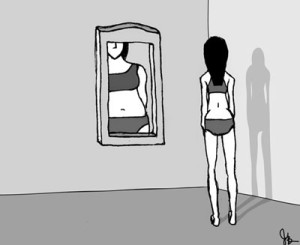 Our media culture is feeding our kids a steady diet of images and body-shape role models through every available outlet. All these messages combine to define a standard of appearance that few will ever reach, but an entire culture is striving to attain. You may wonder why your children are so consumed with spending time in front of the mirror. The answer is simple. They are trying to measure up to the images they’ve seen plastered on TV, the printed page, billboards, etc. The impact on their lives is frightening.
Our media culture is feeding our kids a steady diet of images and body-shape role models through every available outlet. All these messages combine to define a standard of appearance that few will ever reach, but an entire culture is striving to attain. You may wonder why your children are so consumed with spending time in front of the mirror. The answer is simple. They are trying to measure up to the images they’ve seen plastered on TV, the printed page, billboards, etc. The impact on their lives is frightening.
First, we care less about inward character, and more about outward appearance as the primary expression of who we are. Historian Joan Jacobs Brumberg has traced this change in shifting values through American history. In her book, The Body Project: An Intimate History of American Girls, she notes how the lives of girls in the 19th century were oriented towards “good works.” Today, that orientation has shifted to “good looks” as girls have come to view their bodies as the primary expression of their identity.
Second, we denigrate fatness and idolize thinness. Our boys are expected to have bulked-up, fat-less bodies. Our girls are expected to be skinny and thin. One girl told us that the girls in her high school look up to the women who star on TV shows. The pressure shapes their self-concepts, desires, and dreams. That same pressure shapes the way they pose for, take, and post selfies.
Third, because we don’t like what we see in the mirror, we’re very unhappy. By the time they reach the age of thirteen, 53 percent of American girls say they are unhappy with their bodies. By the time they’re seventeen, 78 percent are dissatisfied. The guys aren’t much different.
Fourth, our unhappiness leads us to take measures that are drastic, and sometimes even deadly. We diet, abuse laxatives, work out excessively, get plastic surgery, and take muscle building supplements. Some try to cope through eating disorders. Today, it is estimated that anorexia, the third most common chronic illness in adolescent girls, is estimated to occur in up to three percent of all teenagers.
And finally, we’re learning and living some very sad lessons about a person’s value and worth. On the one hand, we make the mistake of failing to see God’s image, plan, and purpose in ourselves. On the other hand, we do the same to others. Nobody measures up and everyone is disappointed.
What we’ve become is not what we were meant to be. Created with value and worth by a loving God who instilled His own image in each, we are people who need to stop idolizing and pursuing the false god of the perfect body. Instead, we must understand that our priority should be the development of inward character. The Scriptures are clear: God is not concerned with outward appearance. Rather, God is concerned with our hearts. That’s the message we should tell the one we see in the mirror and the message we should pass on to our kids.